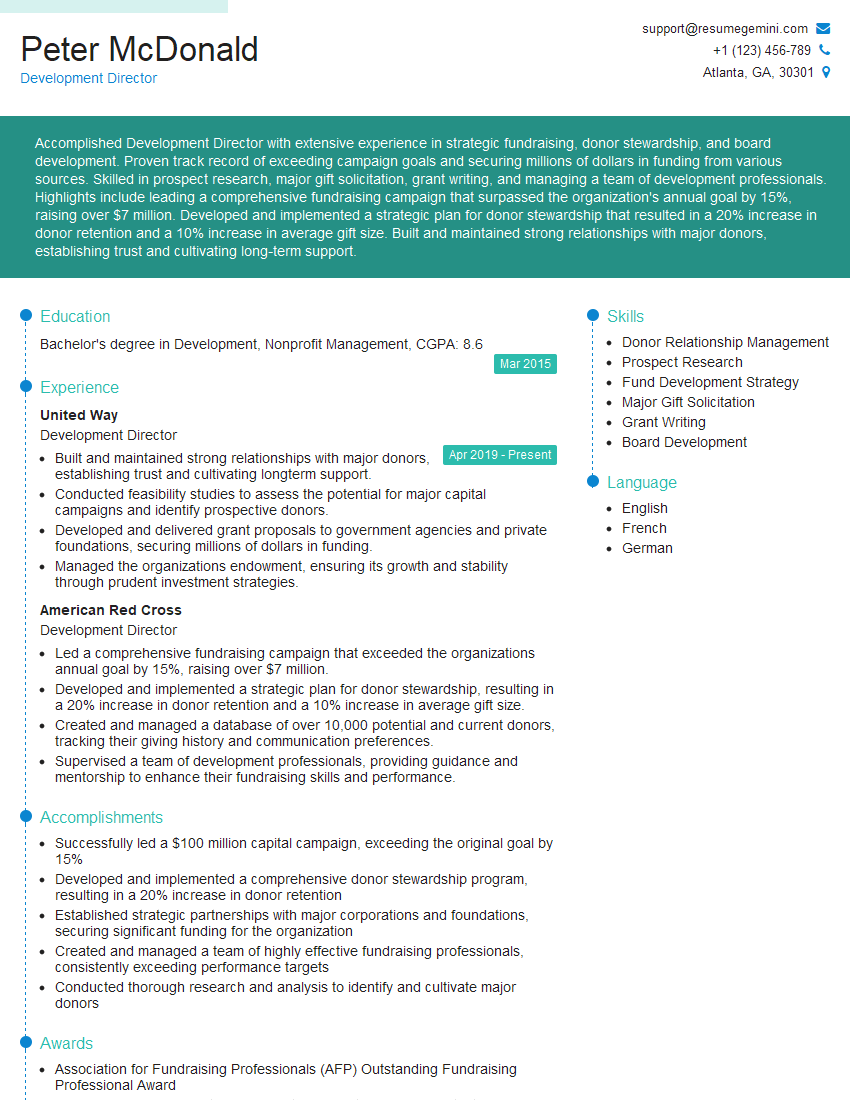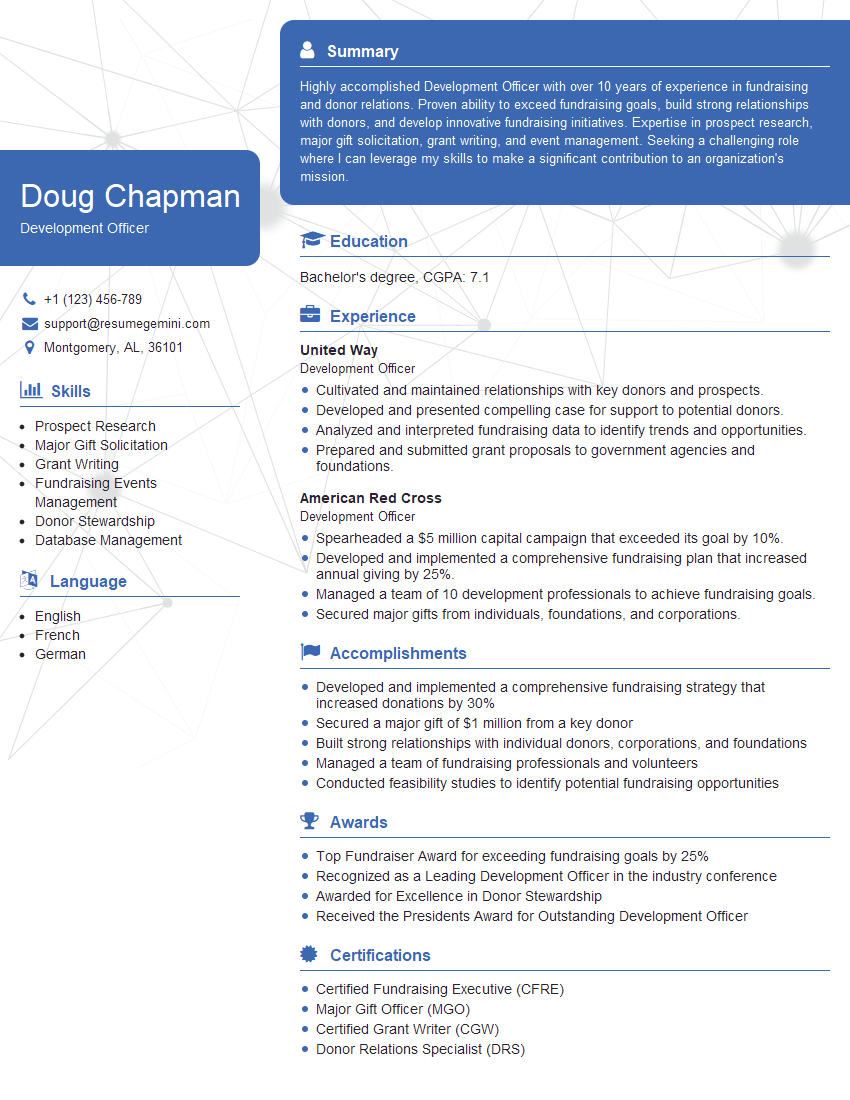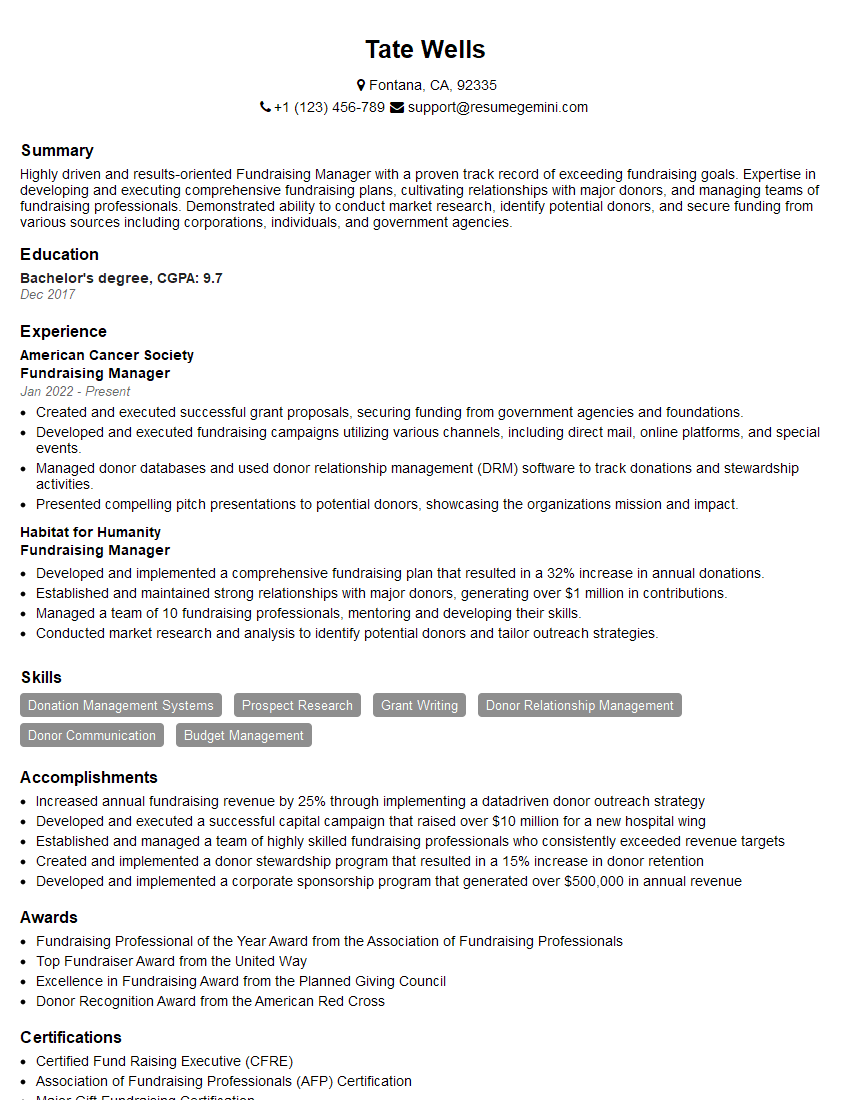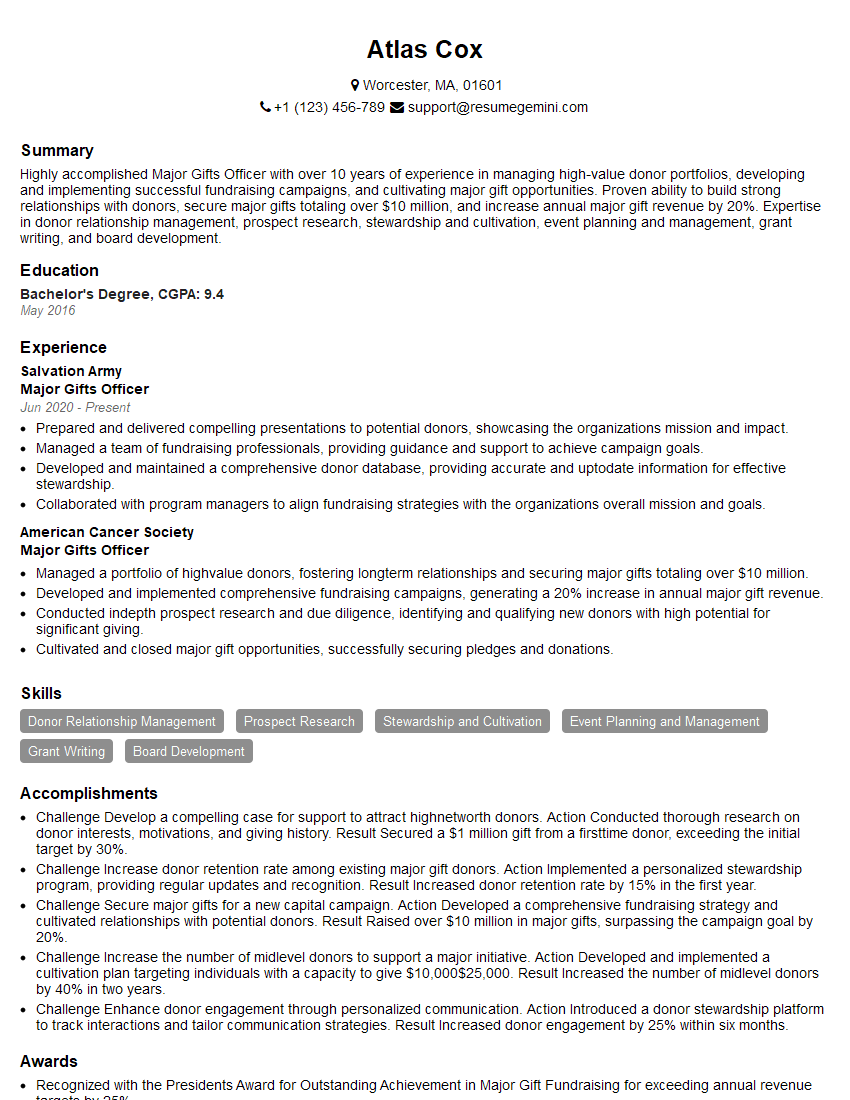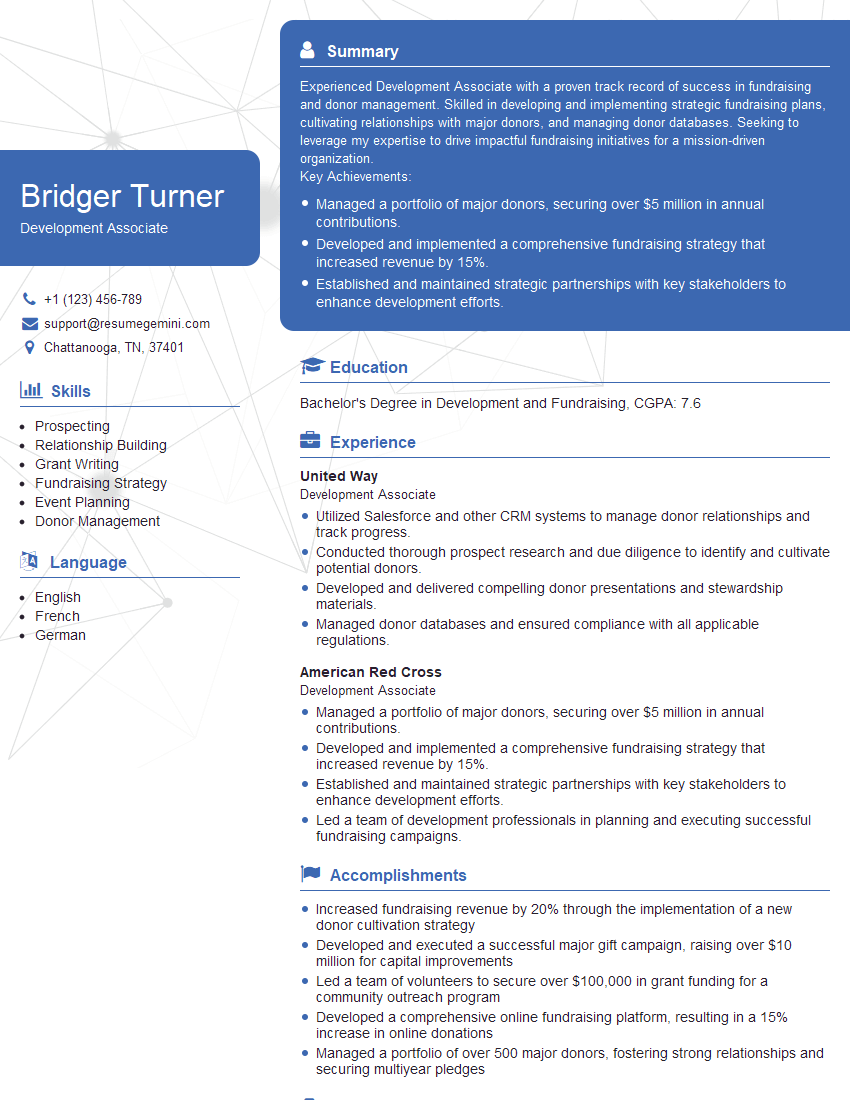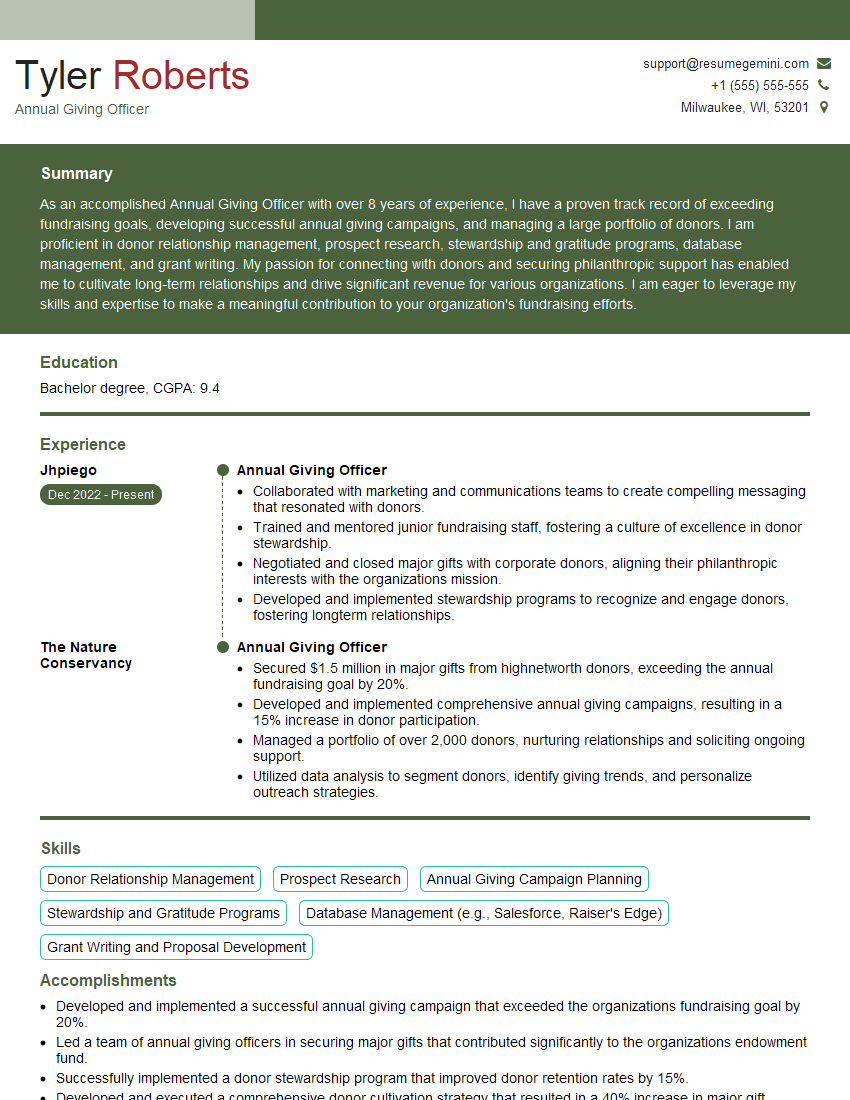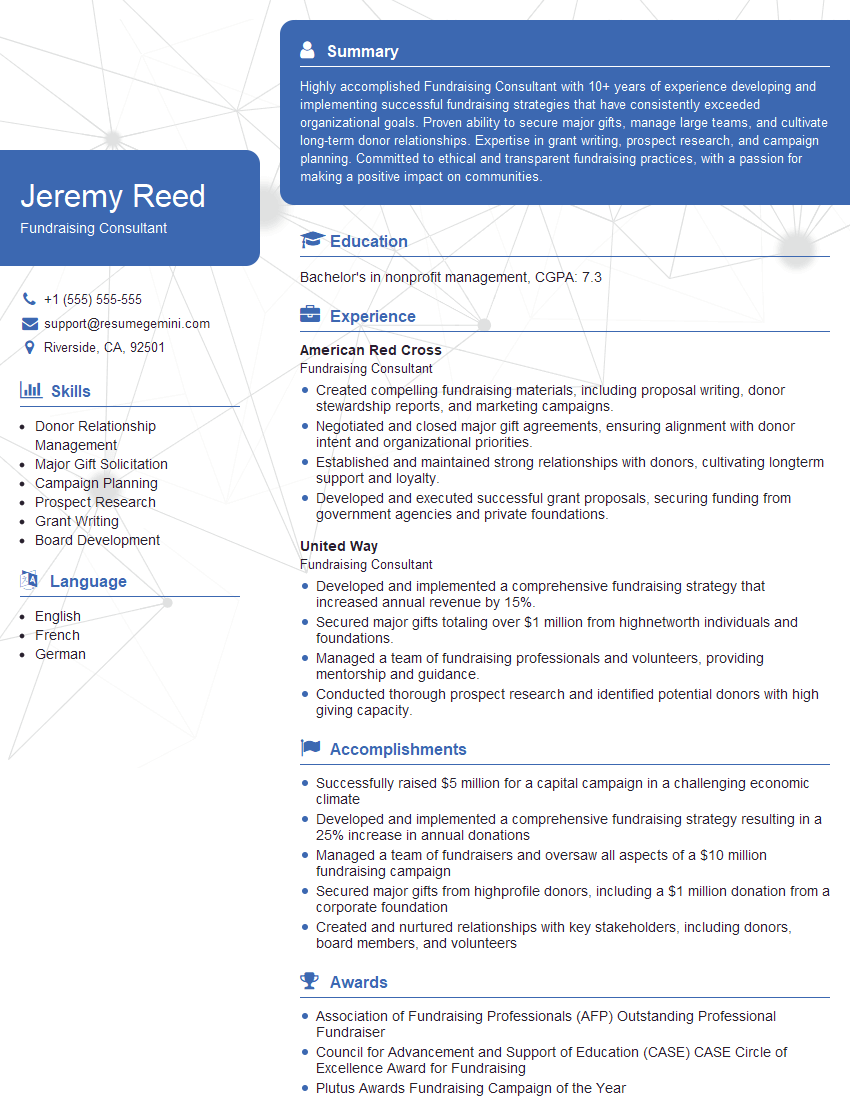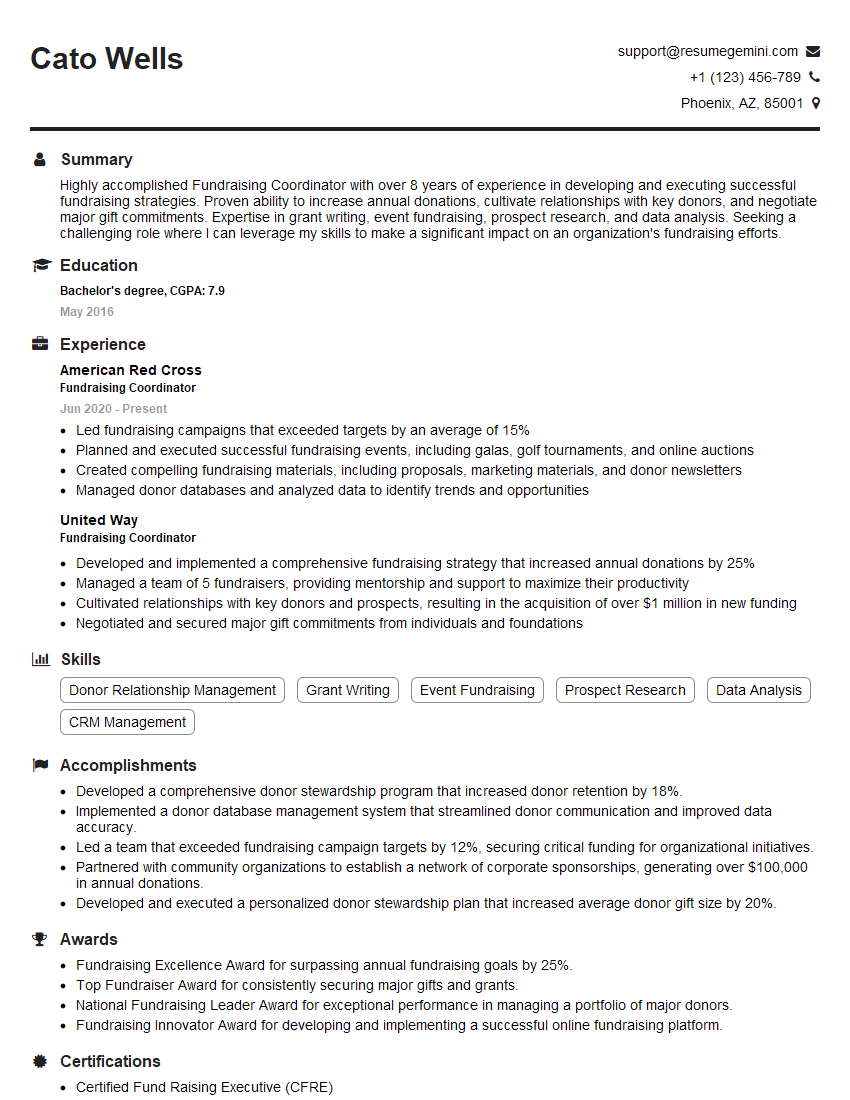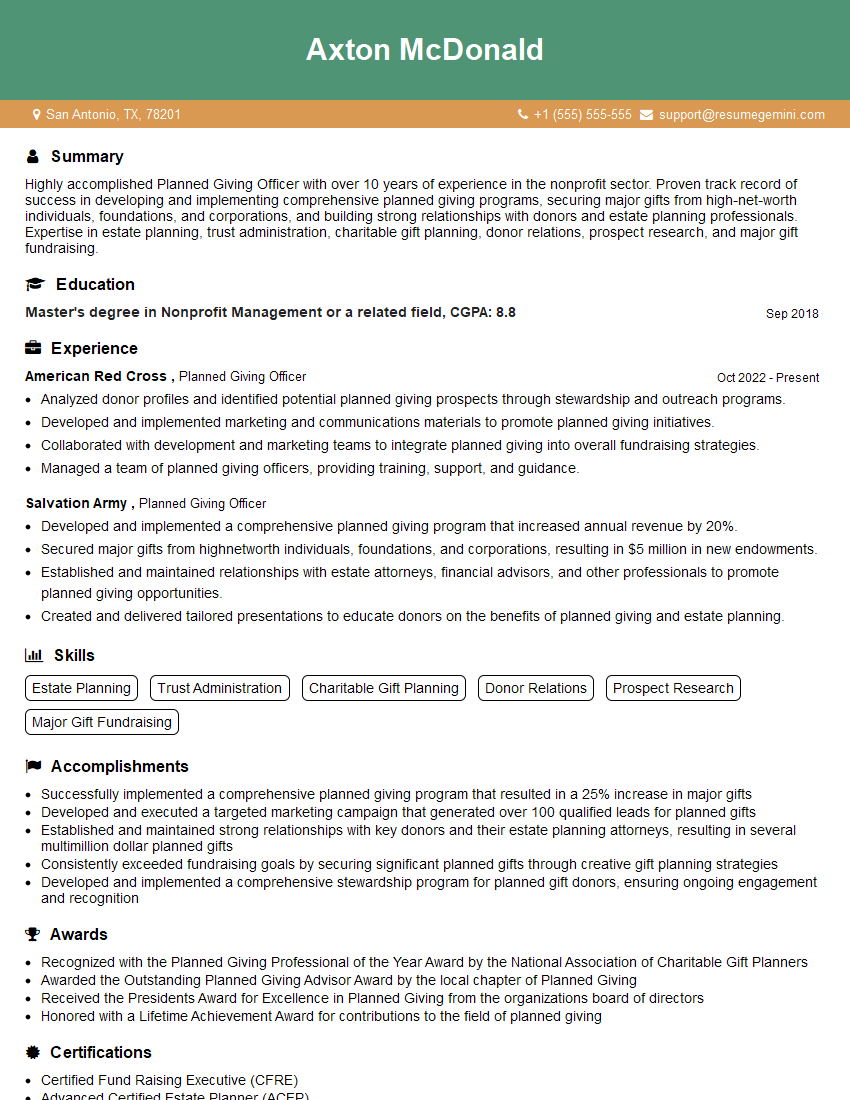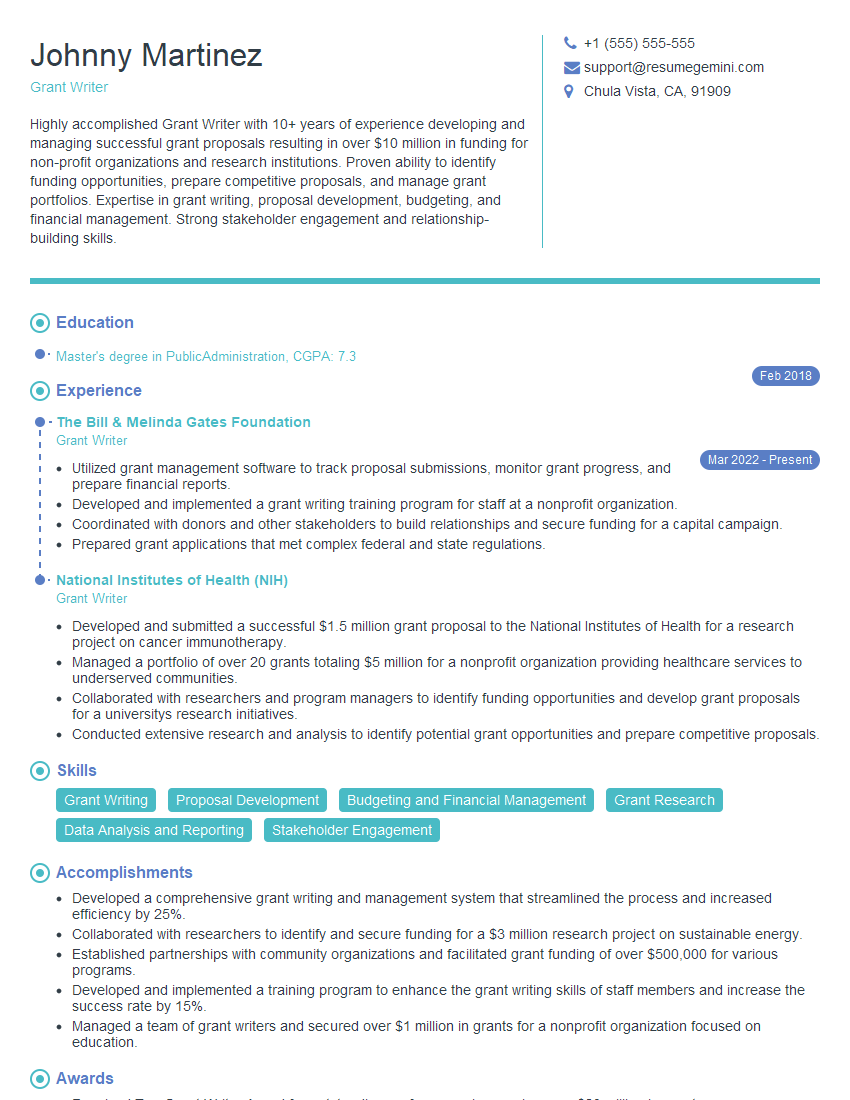Interviews are opportunities to demonstrate your expertise, and this guide is here to help you shine. Explore the essential Fundraising Skills interview questions that employers frequently ask, paired with strategies for crafting responses that set you apart from the competition.
Questions Asked in Fundraising Skills Interview
Q 1. Describe your experience with grant writing, including securing funding.
Grant writing is a crucial fundraising skill, involving crafting compelling proposals to secure funding from foundations, corporations, or government agencies. My experience spans over eight years, during which I’ve successfully secured over $2 million in grants. I’m proficient in researching potential funders, understanding their priorities, and tailoring proposals to resonate with their missions. This involves meticulously researching grant opportunities, crafting a strong narrative that highlights the impact of the project, and meticulously managing the submission process, including adhering to specific deadlines and formatting requirements. For example, I once secured a $250,000 grant from the National Endowment for the Arts for a community theatre program by showcasing its significant community impact and aligning it perfectly with the NEA’s artistic and community engagement goals. Another successful grant involved securing funding from a corporate foundation by demonstrating how our project aligned with their CSR (Corporate Social Responsibility) initiatives, resulting in a $100,000 grant.
- Researching Funding Opportunities: I utilize various databases and online resources to identify suitable grant opportunities.
- Crafting Compelling Narratives: I focus on clear, concise writing that highlights the impact and results of the project.
- Budget Development: I create detailed and justified budgets to demonstrate responsible use of funds.
- Building Relationships: I maintain ongoing communication with grantors to build strong relationships and foster future funding opportunities.
Q 2. Explain your strategy for cultivating major donors.
Cultivating major donors requires a strategic, long-term approach focused on building genuine relationships. My strategy begins with identifying prospective major donors through research and networking. This might involve analyzing donor databases, attending industry events, or leveraging existing connections. Once identified, I prioritize building relationships based on mutual trust and understanding. This isn’t a transactional process; it’s about understanding their philanthropic interests and aligning them with the organization’s mission. I achieve this through personalized communication, regular updates, and invitations to exclusive events. For instance, I successfully cultivated a relationship with a successful entrepreneur by inviting her to a private tour of our organization’s facilities and introducing her to the beneficiaries of our programs. This personal connection led to a significant donation and her becoming a vocal advocate for our cause. The key is to show genuine appreciation and demonstrate the impact of their contributions.
- Identification: Identifying potential major donors based on wealth, philanthropic interests, and alignment with the organization’s mission.
- Relationship Building: Cultivating meaningful connections through personalized communication and engagement.
- Stewardship: Regular communication, impact reporting, and ongoing relationship maintenance.
- Cultivation Events: Organizing exclusive events to foster deeper relationships and build a sense of community.
Q 3. How do you build and maintain strong relationships with donors?
Building and maintaining strong donor relationships is the cornerstone of successful fundraising. It’s about more than just asking for money; it’s about creating a genuine connection. I achieve this through consistent and personalized communication, demonstrating transparency and accountability, and offering various levels of engagement. I regularly send personalized updates on program progress, showcase the impact of donations, and invite donors to participate in relevant events or volunteering opportunities. I also make a point of acknowledging their contributions publicly and privately, showing appreciation for their support. For example, I’ve developed a system for sending handwritten thank-you notes to all donors and regular email updates to major donors that highlight project progress and beneficiary stories. This regular, thoughtful communication fosters a sense of community and helps build strong, long-lasting relationships based on mutual trust and shared purpose.
- Personalized Communication: Regular, tailored updates and thank-you notes.
- Transparency and Accountability: Open communication about how donations are used.
- Donor Recognition: Acknowledging and celebrating donor contributions.
- Engagement Opportunities: Inviting donors to participate in events and volunteer opportunities.
Q 4. What metrics do you use to measure fundraising success?
Measuring fundraising success goes beyond simply tracking the total dollars raised. It requires a comprehensive approach that assesses various metrics to provide a holistic view of performance. Key metrics I utilize include:
- Total Dollars Raised: The overall amount of funds secured during a specific period.
- Donor Acquisition Cost (DAC): The cost of acquiring a new donor, helping assess the efficiency of fundraising efforts.
- Donor Retention Rate: The percentage of donors who continue to contribute year over year.
- Average Gift Size: The average amount donated by each donor, indicating the effectiveness of donor cultivation.
- Number of New Donors: A key indicator of outreach program effectiveness.
- Return on Investment (ROI): The return generated from fundraising investments in terms of dollars raised.
Analyzing these metrics helps identify areas of strength and weakness, allowing for data-driven decision-making to optimize fundraising strategies. For example, if the donor retention rate is low, it might indicate a need to improve donor stewardship practices.
Q 5. How would you approach a fundraising campaign with a limited budget?
A limited budget necessitates a highly strategic and creative approach to fundraising. The focus shifts from large-scale campaigns to leveraging low-cost, high-impact strategies. This could involve:
- Crowdfunding: Utilizing online platforms to leverage the power of social media and network reach.
- Peer-to-Peer Fundraising: Empowering existing supporters to raise funds through their personal networks.
- Grant Writing Focused on Smaller Grants: Targeting smaller grants from local foundations or community organizations.
- Volunteer Recruitment: Leveraging volunteer efforts to reduce operational costs.
- In-Kind Donations: Seeking donations of goods or services instead of cash.
- Strategic Partnerships: Collaborating with other organizations to expand reach and share resources.
For example, I once successfully launched a crowdfunding campaign that significantly exceeded its target, demonstrating the power of utilizing a strategic digital strategy with a compelling narrative on a limited budget.
Q 6. Describe your experience with donor databases and CRM systems.
I’m highly proficient in utilizing donor databases and CRM (Customer Relationship Management) systems. My experience includes working with Raiser’s Edge, DonorPerfect, and Salesforce. I understand the importance of data accuracy and utilize these systems to track donor information, manage communications, analyze fundraising trends, and segment donors for targeted outreach. Effective use of a CRM allows for personalized communication, improved donor stewardship, and more efficient fundraising processes. For instance, using segmentation within a CRM, I’ve been able to create targeted email campaigns that generate higher response rates and larger donations compared to generic mailings. Regular data cleaning and updates are essential to ensure the accuracy and efficacy of these tools.
- Data Entry and Management: Ensuring data accuracy and integrity within the system.
- Reporting and Analytics: Using the CRM to generate reports and analyze fundraising performance.
- Donor Segmentation: Dividing donors into groups based on giving history, demographics, and other factors to create targeted outreach.
- Communication Management: Using the system to manage and track communications with donors.
Q 7. How do you identify and prioritize potential funding sources?
Identifying and prioritizing potential funding sources requires a systematic approach. I begin by researching potential funders, considering their mission, giving history, and grant-making priorities. This research involves exploring various databases, attending industry events, and networking with other professionals. Once a list of potential funders is compiled, I prioritize them based on factors such as alignment with the organization’s mission, past funding history, and the likelihood of success. I use a scoring system to evaluate each potential funder, considering factors such as grant size, restrictions, and application requirements. This allows me to focus on the most promising sources and allocate my time and resources effectively. For example, I might prioritize foundations that have previously funded similar projects or those with a strong alignment with our organization’s mission. This strategic approach maximizes the chances of securing funding and reduces wasted effort.
- Research: Identifying potential funding sources through online databases, networking, and industry events.
- Prioritization: Evaluating potential funders based on alignment with the organization’s mission, past funding history, and likelihood of success.
- Scoring System: Creating a scoring system to rank potential funders based on various factors.
- Relationship Building: Cultivating relationships with potential funders to increase the chances of securing funding.
Q 8. Explain your understanding of different fundraising techniques (e.g., direct mail, online, events).
Fundraising techniques are diverse, each with its strengths and weaknesses. Successful fundraising often involves a multi-channel approach.
- Direct Mail: This traditional method involves sending physical letters, brochures, or other materials to potential donors. It’s effective for building relationships and creating a tangible connection, particularly with older demographics. However, it’s expensive and has lower response rates than some digital methods. A successful direct mail campaign relies on compelling copy, targeted lists, and meticulous tracking of responses.
- Online Fundraising: This encompasses a wide range of techniques, including website donations, crowdfunding platforms (like GoFundMe or Kickstarter), email marketing, and social media campaigns. It’s cost-effective, allows for easy tracking and analysis, and reaches a wider audience. A strong online strategy requires a user-friendly website, engaging content, and a robust email marketing system. For example, a compelling video story on a crowdfunding page can drastically increase donations.
- Events: Fundraising events, such as galas, walks, or auctions, offer opportunities for face-to-face interaction with donors and building community. They can generate significant revenue, enhance brand awareness, and foster donor loyalty. However, events require significant planning, logistical coordination, and often rely on securing sponsorships in addition to ticket sales. Successfully managing the event budget and volunteer teams is crucial.
In my experience, the most effective fundraising strategies combine these techniques to create a holistic approach. For instance, a major fundraising event could be supported by a pre-event email campaign and a follow-up direct mail piece thanking attendees and soliciting additional donations.
Q 9. What is your experience with prospect research?
Prospect research is crucial for identifying potential donors who align with the organization’s mission and have the capacity and inclination to give. It’s about more than just finding wealthy individuals; it’s about understanding their philanthropic interests and motivations.
My experience includes utilizing a variety of research tools, including online databases (like GuideStar or WealthEngine), social media analysis, and networking within the community. I’ve developed a structured approach that involves:
- Identifying potential prospects: This might involve reviewing lists of previous donors, attending industry events, or analyzing social media activity.
- Gathering information: This step involves researching potential donors’ backgrounds, giving history, professional achievements, and philanthropic interests.
- Assessing giving capacity and inclination: This requires evaluating their net worth, past giving patterns, and alignment with the organization’s mission.
- Developing a cultivation strategy: Once a prospect’s profile is developed, a tailored strategy can be created for engaging them and soliciting a donation.
For example, I once identified a successful entrepreneur who had a strong interest in environmental conservation through meticulous online research. This led to a highly successful cultivation strategy resulting in a major gift.
Q 10. How do you handle donor objections or concerns?
Handling donor objections or concerns requires empathy, active listening, and a solution-oriented approach. The key is to understand the root of the concern and address it directly, honestly, and respectfully.
My approach involves:
- Actively listen and acknowledge their concerns: Let the donor express their thoughts without interruption. Show that you value their perspective.
- Empathize and validate their feelings: Express understanding and show that you take their concerns seriously.
- Address their concerns directly and honestly: Provide clear and concise answers, even if the news is not positive. Transparency is essential.
- Offer solutions or alternatives: Explore options that address the donor’s concerns while still advancing the organization’s mission.
- Follow up: After the conversation, send a thank-you note summarizing the discussion and the agreed-upon actions.
For instance, if a donor questions the organization’s use of funds, I would provide a detailed breakdown of the budget and demonstrate how their contribution directly impacts the programs they support. If a donor expresses concerns about transparency, I will provide access to annual reports and other relevant documents.
Q 11. Describe your experience with reporting on fundraising results.
Reporting on fundraising results is vital for demonstrating accountability, measuring progress, and making data-driven decisions. My reporting encompasses a combination of quantitative and qualitative data, presented in a clear and concise manner.
My experience includes creating reports that track:
- Key performance indicators (KPIs): Such as total donations, number of donors, average gift size, donor retention rate, and cost per acquisition.
- Campaign performance: Evaluating the success of individual campaigns, highlighting areas of strength and weakness.
- Donor demographics and giving patterns: Analyzing donor data to identify trends and inform future fundraising strategies.
- Budget variance: Comparing actual results against the budget, explaining any significant deviations.
I utilize various tools, including spreadsheets, databases, and fundraising software to generate reports. For example, a visual dashboard showing key KPIs over time can help stakeholders quickly understand the organization’s progress toward its fundraising goals. Detailed campaign reports help to evaluate the effectiveness of different fundraising approaches, informing future investment decisions.
Q 12. How do you ensure donor privacy and compliance with regulations?
Ensuring donor privacy and compliance with regulations is paramount. It builds trust, protects the organization’s reputation, and avoids legal penalties. This involves adhering to relevant laws (like GDPR, CCPA, etc.), implementing robust data security measures, and maintaining transparent communication with donors.
My approach focuses on:
- Data security: Utilizing secure data storage and transmission methods, implementing access control measures, and regularly updating security protocols.
- Privacy policies: Developing and maintaining clear and concise privacy policies that inform donors how their data will be collected, used, and protected.
- Consent management: Obtaining explicit consent before collecting and using donor data, ensuring the ability for donors to withdraw consent at any time.
- Data minimization: Only collecting and retaining the minimum necessary data to fulfill the organization’s purpose.
- Transparency: Being open and honest with donors about how their information is used and protected.
For example, I ensure all donor data is encrypted, access is restricted to authorized personnel, and regular security audits are performed. We also provide clear and readily accessible privacy policies on our website and in all communication materials.
Q 13. What is your understanding of gift planning and planned giving?
Gift planning, also known as planned giving, involves securing future commitments from donors through techniques like bequests, charitable gift annuities, and charitable remainder trusts. It’s a crucial aspect of long-term fundraising, providing a predictable stream of income and ensuring the organization’s financial stability.
My understanding encompasses:
- Bequests: Gifts made through a will, specifying a donation to the organization after the donor’s death.
- Charitable Gift Annuities: Arrangements where the donor receives regular payments for life in exchange for a charitable contribution.
- Charitable Remainder Trusts: Trusts that provide income to the donor (or another beneficiary) for a specified period and then transfer the remaining assets to the organization.
- Life insurance gifts: Donating a life insurance policy to the organization.
Successfully implementing gift planning requires building strong relationships with donors, educating them about the benefits of planned giving, and providing them with the necessary legal and financial guidance. It’s about fostering long-term partnerships and creating a legacy for the donor.
Q 14. How do you segment your donor base for targeted fundraising efforts?
Donor segmentation is essential for crafting targeted fundraising appeals that resonate with specific donor groups. It allows for more effective communication and increased fundraising success. Instead of a one-size-fits-all approach, segmentation allows for personalization.
My approach involves segmenting donors based on several factors:
- Giving history: Past donation amounts, frequency, and methods.
- Demographics: Age, location, occupation, and other relevant characteristics.
- Philanthropic interests: Areas of the organization’s work that the donor supports.
- Engagement level: Frequency of communication, attendance at events, and volunteer activity.
For instance, I might segment donors into groups like “major donors,” “recurring donors,” “first-time donors,” and “lapsed donors.” Each group would then receive tailored communications and fundraising appeals based on their individual profiles and preferences. This approach allows me to tailor my messaging to resonate more effectively and improve the overall success rate of fundraising efforts.
Q 15. Describe a successful fundraising campaign you have managed or participated in.
One particularly successful campaign I spearheaded involved raising funds for a local children’s hospital’s new pediatric oncology ward. The campaign, titled “Hope Blooms,” leveraged a multi-faceted approach. We started with a compelling narrative highlighting the urgent need for improved facilities and the positive impact on the young patients and their families. This story was woven into all our communications.
We utilized a tiered giving system, offering various donation levels with corresponding benefits, such as naming rights for rooms or recognition on the hospital’s donor wall. This catered to a wider range of donors’ capacities. A crucial element was the strong visual component – we created stunning photography and videos showcasing the children and the positive impact of the hospital. These were shared across our website, social media channels, and email marketing. We also organized a series of fundraising events, including a gala dinner and a community walk-a-thon, generating both significant donations and community engagement. Finally, we fostered strong relationships with media outlets to garner positive press coverage, enhancing the campaign’s visibility and credibility. The campaign exceeded its target by 15%, demonstrating the effectiveness of a holistic, strategically planned, and emotionally resonant approach.
Career Expert Tips:
- Ace those interviews! Prepare effectively by reviewing the Top 50 Most Common Interview Questions on ResumeGemini.
- Navigate your job search with confidence! Explore a wide range of Career Tips on ResumeGemini. Learn about common challenges and recommendations to overcome them.
- Craft the perfect resume! Master the Art of Resume Writing with ResumeGemini’s guide. Showcase your unique qualifications and achievements effectively.
- Don’t miss out on holiday savings! Build your dream resume with ResumeGemini’s ATS optimized templates.
Q 16. How do you manage multiple projects simultaneously and meet deadlines?
Managing multiple fundraising projects requires a robust organizational system. I rely heavily on project management software, such as Asana or Trello, to track tasks, deadlines, and progress across all projects. Each project has a detailed timeline with clearly defined milestones and responsibilities. I also prioritize tasks using methods like the Eisenhower Matrix (urgent/important), ensuring that the most critical activities for each project are addressed first. Regular team meetings help maintain transparency and allow for collaborative problem-solving. Finally, consistent communication with stakeholders keeps everyone informed and aligned. Think of it like conducting an orchestra – each instrument (project) needs its own part, but the conductor (me) ensures they all harmonize to create a beautiful symphony (meeting deadlines).
Q 17. What is your experience with developing and managing a fundraising budget?
Developing and managing a fundraising budget requires meticulous planning and forecasting. It begins with defining realistic fundraising goals based on past performance, market research, and potential donor capacity. I then allocate resources across different fundraising initiatives, considering their projected return on investment. The budget includes detailed line items for expenses such as marketing materials, event costs, staff time, and technology platforms. Regular monitoring and adjustments are crucial to ensure the budget remains on track. For example, if a particular fundraising event is underperforming, I might reallocate resources to more effective strategies. Financial reports are prepared regularly to track progress and identify areas needing attention. Transparency and accountability are paramount – donors should be able to see how their contributions are being utilized effectively.
Q 18. How familiar are you with online fundraising platforms and social media for fundraising?
I’m highly proficient in leveraging online fundraising platforms and social media for fundraising. I have experience with platforms like GoFundMe, Donorbox, and Give Lively, understanding their unique features and functionalities. On social media, I utilize platforms like Facebook, Instagram, and Twitter to build community engagement, share compelling storytelling, and drive donations. I create targeted advertising campaigns to reach specific donor demographics. I also utilize social media analytics to track campaign performance and refine strategies based on data-driven insights. For instance, understanding which social media posts generate the highest engagement allows for content optimization, leading to better results. I also know how to leverage influencer marketing on social media to reach a broader audience. This is a really effective way to broaden the reach of your message and engage with people who might not otherwise be aware of your cause.
Q 19. How would you address a decline in donations?
A decline in donations requires a systematic approach to diagnosis and remediation. First, I’d analyze the data to identify the root cause. Factors to consider include economic downturns, changes in donor demographics, competing fundraising campaigns, or dissatisfaction with the organization’s communication. Once the cause is identified, I would develop a targeted strategy. This could involve strengthening donor relationships through personalized communication, improving the organization’s transparency, launching a new fundraising campaign with a fresh approach, or expanding outreach to new donor segments. It might also include re-evaluating existing communication strategies or exploring new ways of engaging potential donors, such as through volunteer opportunities or stewardship programs.
Q 20. Explain your experience in developing compelling fundraising proposals.
Developing compelling fundraising proposals is key to securing funding. I begin by thoroughly understanding the needs of the prospective funder, their priorities, and their past funding patterns. The proposal must clearly articulate the problem the organization addresses, the proposed solution, the organization’s capacity to deliver, and the anticipated impact. Strong proposals use data and evidence to support their claims. A compelling narrative that resonates emotionally with the reader is also crucial. Finally, the proposal must be clear, concise, well-written, and visually appealing. A well-structured proposal includes a clear executive summary, detailed project description, budget justification, evaluation plan, and information on the organization’s history and track record. Think of it as a sales pitch – you need to convince the funder that investing in your cause is a smart and worthwhile decision.
Q 21. How do you tailor your fundraising approach to different donor types?
Tailoring the fundraising approach to different donor types is essential for maximizing success. I segment donors based on their giving history, demographics, and engagement levels. For example, major gift donors require a personalized approach with one-on-one cultivation, building trust and demonstrating the impact of their gifts. Mid-level donors might be approached through targeted email campaigns and invitations to exclusive events. Small-dollar donors might respond to broader appeals and online fundraising platforms. I craft different messaging and communication strategies to resonate with each segment, ensuring that the ask is appropriate and the benefits are clearly articulated. Understanding donor motivations is key; a passionate environmentalist will respond differently to a conservation appeal than a business leader focused on social impact. Therefore, I adapt my approach to align with each donor’s personal values and interests.
Q 22. What are your salary expectations for this role?
My salary expectations are commensurate with my experience and the responsibilities of this role. Having successfully managed multi-million dollar fundraising campaigns and consistently exceeded targets in my previous positions, I’m confident my skills align perfectly with this opportunity. I’m open to discussing a specific range after learning more about the complete compensation package and benefits offered.
Q 23. How do you stay current with trends and best practices in fundraising?
Staying current in fundraising is crucial. I utilize several strategies: I subscribe to leading fundraising publications like Fundraising Success and The Chronicle of Philanthropy. I actively participate in professional development opportunities such as webinars, conferences (like AFP ICON), and workshops offered by organizations like the Association of Fundraising Professionals (AFP). I also follow key influencers and thought leaders on platforms like LinkedIn and Twitter. Furthermore, I regularly analyze benchmarking data from similar organizations to identify best practices and adapt them to my own work. This ensures my strategies remain innovative and effective.
Q 24. Describe your experience with fundraising events and their planning.
I have extensive experience planning and executing a variety of fundraising events, from intimate galas to large-scale community events. My process typically involves:
- Needs Assessment: Defining clear goals and objectives for the event.
- Budgeting and Resource Allocation: Creating a detailed budget and securing necessary resources.
- Marketing and Promotion: Developing a comprehensive marketing strategy to reach the target audience.
- Logistics and Venue Management: Coordinating all aspects of event logistics, including venue selection, catering, and staffing.
- Volunteer Recruitment and Management: Recruiting and managing a team of volunteers to assist with event execution.
- Post-Event Evaluation: Analyzing event data to identify areas for improvement in future events.
For example, at my previous organization, I successfully planned and executed a yearly gala that increased net proceeds by 20% year-over-year for three consecutive years, through innovative sponsorship packages and targeted guest invitations.
Q 25. How do you measure the ROI of your fundraising efforts?
Measuring ROI in fundraising isn’t simply about dollars raised. It’s about assessing the overall impact of our efforts. I use a multifaceted approach:
- Cost per acquisition (CPA): Calculating the cost of acquiring each donor or sponsor.
- Donor retention rate: Tracking the percentage of donors who continue to give.
- Average gift size: Monitoring the average amount donated by each donor.
- Overall fundraising revenue: Tracking the total amount raised across all initiatives.
- Qualitative metrics: Assessing increases in brand awareness, volunteer engagement, and community relationships.
For instance, if a campaign cost $10,000 to implement and raised $100,000, the direct ROI is 1000%, but a deeper analysis would look at donor acquisition costs, retention rates, and long-term giving potential for a more holistic understanding.
Q 26. What is your experience with corporate sponsorship acquisition?
Securing corporate sponsorships requires building strong relationships and presenting compelling value propositions. My approach involves:
- Identifying Potential Sponsors: Researching companies whose values align with the organization and whose target audience overlaps with our donor base.
- Crafting Compelling Proposals: Developing customized sponsorship packages that offer tangible benefits to sponsors, such as brand visibility, event tickets, and networking opportunities.
- Relationship Building: Cultivating strong relationships with potential sponsors through regular communication and networking events.
- Negotiation and Contract Management: Negotiating favorable sponsorship terms and managing contracts effectively.
In my previous role, I secured a six-figure sponsorship from a major corporation by demonstrating how a strategic partnership could positively impact their brand image while supporting a vital cause. The key was aligning their business objectives with our fundraising goals.
Q 27. What is your approach to building a diverse and inclusive fundraising program?
Building a diverse and inclusive fundraising program is paramount for ethical and effective fundraising. My approach encompasses:
- Diverse Outreach Strategies: Employing a multi-channel approach to reach diverse communities, using culturally sensitive language and media channels.
- Inclusive Event Planning: Ensuring events are accessible and welcoming to individuals from all backgrounds and abilities.
- Equitable Donor Cultivation: Cultivating relationships with donors from diverse backgrounds and socioeconomic statuses.
- Board and Staff Diversity: Promoting diversity at all levels of the organization to ensure varied perspectives inform fundraising strategies.
For example, I’ve worked to develop fundraising materials in multiple languages and made it a point to include people of diverse ethnicities and abilities in our event marketing materials, thereby creating a more welcoming environment for a wider pool of donors.
Q 28. How do you adapt your fundraising strategy to different economic climates?
Adapting to economic climates necessitates flexibility and strategic thinking. During economic downturns, I would:
- Adjust Fundraising Goals: Setting more realistic, achievable goals based on market conditions.
- Diversify Funding Sources: Exploring multiple funding streams to reduce reliance on any single source.
- Enhance Donor Communication: Increasing communication frequency and transparency with donors to build trust and understanding.
- Develop Targeted Campaigns: Crafting campaigns that resonate with donors during challenging times by emphasizing community impact and demonstrable results.
- Optimize Costs: Reviewing program expenses and finding cost-effective alternatives while maintaining quality.
For example, during a recent recession, I shifted the focus from large, high-ticket galas to smaller, more affordable events and created crowdfunding campaigns targeting a wider, more diverse audience, adapting to the changing giving patterns while still reaching ambitious goals.
Key Topics to Learn for Fundraising Skills Interview
- Understanding Donor Needs and Motivations: Explore different donor profiles, their philanthropic goals, and how to tailor your approach for maximum impact.
- Developing Compelling Fundraising Proposals: Learn to craft persuasive narratives, articulate a clear vision, and demonstrate the impact of donations with strong data and storytelling.
- Grant Writing and Research: Master the art of identifying suitable grant opportunities, conducting thorough research, and writing compelling grant proposals that align with funder priorities.
- Cultivating Donor Relationships: Understand the importance of building rapport, maintaining communication, and fostering long-term partnerships with donors.
- Fundraising Events and Campaigns: Learn to plan, execute, and evaluate successful fundraising events, online campaigns, and other outreach initiatives.
- Budget Management and Financial Reporting: Understand the importance of managing fundraising budgets effectively and accurately reporting on fundraising outcomes to stakeholders.
- Digital Fundraising Strategies: Explore online fundraising platforms, social media engagement, and digital marketing techniques to broaden reach and maximize impact.
- Ethical Fundraising Practices: Understand and adhere to ethical guidelines and best practices within the fundraising profession.
- Fundraising Data Analysis and Reporting: Learn to analyze fundraising data to track progress, measure impact, and make data-driven decisions to optimize strategies.
- Problem-solving and Adaptability: Demonstrate your ability to address unforeseen challenges, adapt to changing circumstances, and find creative solutions to overcome obstacles in fundraising.
Next Steps
Mastering fundraising skills is crucial for career advancement in the non-profit sector and beyond. It opens doors to impactful roles where you can make a real difference. To significantly boost your job prospects, create an ATS-friendly resume that highlights your achievements and skills effectively. ResumeGemini is a trusted resource that can help you build a professional and compelling resume. We provide examples of resumes tailored to Fundraising Skills to help you craft your perfect application. Take the next step towards your dream fundraising career today!
Explore more articles
Users Rating of Our Blogs
Share Your Experience
We value your feedback! Please rate our content and share your thoughts (optional).
